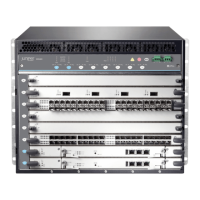•
ETHERNET or MGMT—Connects the Routing Engine through an Ethernet connection
to a management LAN (or any other device that plugs into an Ethernet connection)
forout-of-band management. The port uses an autosensing RJ-45 connector to support
10-Mbps or 100-Mbps connections. Two small LEDs on the right of the port indicate
the connection in use: The LED on the left indicates speed—green for 1000-Mbps,
yellow for 100-Mbps and when the LED is dark, it indicates 10-Mbps speed. The LED
on the right indicates activity—flashing green when packets are passing through the
port.
Routing Engine Boot Sequence
The Routing Engine boots from the storage media in this order: the USB device (if present),
then the CompactFlash card, then the hard disk, then the LAN. The disk from which the
router boots is called the primary boot device, and the other disk is the alternate boot
device.
NOTE: If the routerboots from an alternate boot device, a yellowalarm lights
the LED on the router’s craft interface.
Booting in a RE-S-X6-64G Routing Engine follows this sequence—the USB device, SSD1,
SSD2, and LAN. SSD1 is the primary boot device. Boot sequence is tried twice for SSD1
and SSD2.
If the Routing Engines are configured for graceful switchover, the backup Routing Engine
automatically synchronizes its configuration and state with the master Routing Engine.
Any update to the master Routing Engine state is replicated on the backup Routing Engine.
If the backup Routing Engine assumes mastership, packet forwarding continues through
the router without interruption. For more information about graceful switchover, see the
Junos OS Administration Library.
NOTE: If two Routing Engines are installed, they must both be the same
hardware model.
Related
Documentation
MX480 Router Description on page 3•
• MX480 Routing Engine LEDs on page 38
• MX480 Host Subsystem Description on page 25
• MX480 SCB Description on page 107
RE-S-1800 Routing Engine Description for MX Series
Figure 15 on page 30 shows the Routing Engine 1800.
29Copyright © 2017, Juniper Networks, Inc.
Chapter 5: Host Subsystem Components and Descriptions

